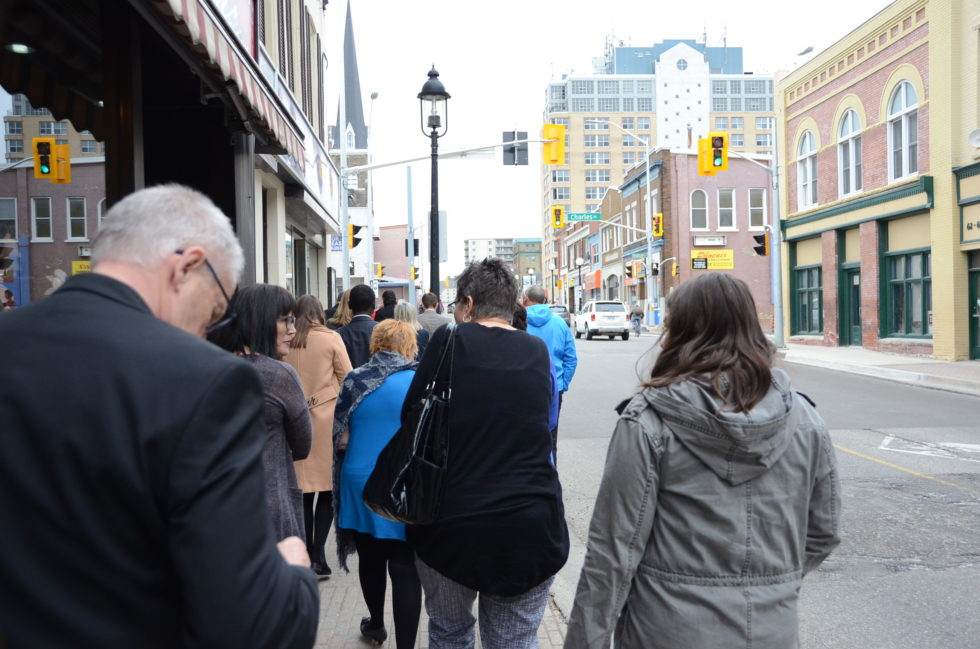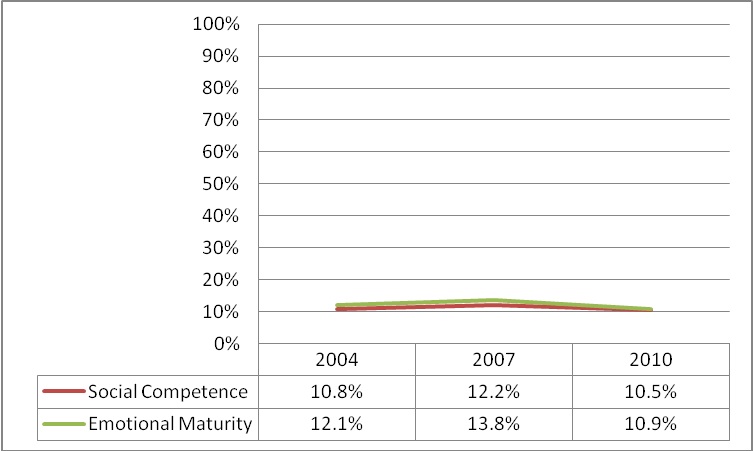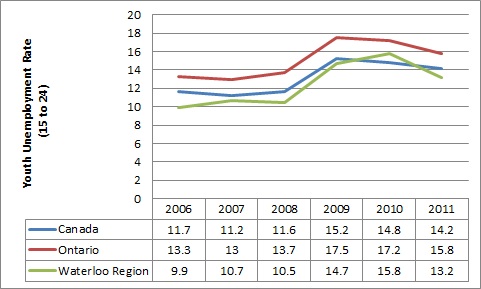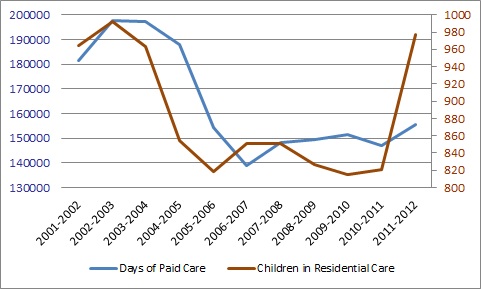Posts Tagged ‘evidence based practice’
Posted on: April 5th, 2017 by Waterloo Region Crime Prevention Council
On March 30th and 31st 2017, the Waterloo Region Crime Prevention Council hosted the 2017 Canadian Municipal Network on Crime Prevention (CMNCP) at the Walper Hotel. During this two-day event, members of the network, representing 24 different municipalities across the nation, attended interactive lectures led by leaders in public engagement, mental health, and community development. They participated in round table discussions pertaining to increasing both the capacity for crime prevention as a whole and the CMNCP capacity.
Attendees also had the chance to network with other members regarding their experiences with crime prevention in their own municipalities. It was a pleasure to host this hardworking group here in Waterloo Region. We look forward to the continued work ahead!

The attending CMNCP members at the reception hosted by Waterloo Region Chair, Ken Seiling. -Waterloo Region Museum.
A few additional photos of the event proceedings

The CMNCP National Meeting was kicked off with an Indigenous Welcome & land Acknowledgement by Darren Thomas

Presentation & Dialogue with Don Lenihan on Public Engagement with Government & Community

Professor Irvin Waller from the University of Ottawa speaking during the CMNCP national meeting

Members of the CMNCP listening intently to a presentation.

Felix Munger had the distinguished task of keeping the CMNCP proceedings on schedule!

We were very pleased to host Juma Assiago from the UN- Habitat program at CMNCP. Juma supports international cities wanting to address complex crime issues through ‘safe city’ initiatives.

As this was a national meeting, all proceedings were delivered via simultaneous translation

Joe Mencini from the Working Centre explaining the ins-and-outs of the community agency

The group gets to leave the meeting table for a field trip to The Working Centre

The group gets to leave the meeting table for a field trip to The Working Centre

Members of the CMNCP make a visit to the WRCPC office & historic goal in downtown Kitchener

Chief Bryan Larkin of the Waterloo Region Police Services speaking at the Gaol

Regional Chair Ken Seiling was the host for the CMNCP reception held at the Waterloo

CMNCP Co-Chair Patrice Allard speaking at the reception.

Deputy Chief Kevin Thaler of the Waterloo Region Police Services giving a speech at the reception

CMNCP members gather around the podium at the Waterloo Region Museum for a welcome address.

WRCPC Chair Shayne Turner speaking to the guests at the reception

Dianne Hiese & Chris Cowie catching up at the reception

Hard at work during meeting sessions


Patrick Smith delivers a presentation on the “Potential of Federated Organizations”
Posted on: November 23rd, 2016 by Waterloo Region Crime Prevention Council
 All of the calls to action already mentioned in the previous blog posts (humanizing people in prison & advocating for programs that work) help to create and strengthen system change in big and small ways. The work of larger structural change is long term, often slow work: Not for the faint of heart, but everyone can still play a role.
All of the calls to action already mentioned in the previous blog posts (humanizing people in prison & advocating for programs that work) help to create and strengthen system change in big and small ways. The work of larger structural change is long term, often slow work: Not for the faint of heart, but everyone can still play a role.
Here are a few ways you or your friends can contribute toward society and system changes.
- Male Allies Against Sexual Violence – Through public education, the Male Allies program invites men and boys to be leaders in the work of ending gender-based violence. Their goal is to encourage critical introspection in men and boys, which begins by helping them to understand gender-based violence as a men’s issue. Over the past eight years, they have offered hundreds of workshops to thousands of men and boys and have just started a ground-breaking training initiative with the Ontario Hockey League.
- Learn more about the root causes of crime. In order to prevent something, it’s important to understand the contributing factors. As a community, we have the responsibility to address these conditions which hinder healthy development and can lead to criminal behaviour.
- Learn more about Smart on Crime approaches to addressing crime. Everyone has heard about tough on crime, but what about Smart on Crime? As a community, we can use language that shows we can build a community that is safe and vibrant for all people living in Waterloo Region.
- Follow the advocacy work of Howard Sapers – Until recently, Howard Sapers was the Correctional Investigator of Canada responsible for the investigation of individual and systemic concerns. He was also a guest for a 2015 Friends of Crime Prevention event. On November 8, the Ontario Government appointed Mr. Sapers to be an independent advisor on corrections reform and to provide advice to the government on the use of segregation and ways to improve the province’s adult corrections system.
When we have people and community organizations working at all three areas of action to humanize people in prison and reduce stigma for loved ones, advocate for programs that work and enter into deeper levels of system and societal change, we can move the needle on progressive change.
If you decide to take some action, we would love to hear about it – 6 weeks from now, or 6 months from now! Get in touch with Juanita Metzger to share your story.
Posted on: November 23rd, 2016 by Waterloo Region Crime Prevention Council
 Inevitably, the Turn the Page book club discussions turned to the support provided to people in prison while they serve their sentences and the programs and support available during parole or upon release. Many people in attendance admitted to not knowing the reality facing people on the ‘inside’.
Inevitably, the Turn the Page book club discussions turned to the support provided to people in prison while they serve their sentences and the programs and support available during parole or upon release. Many people in attendance admitted to not knowing the reality facing people on the ‘inside’.
The past 5-7 years have seen a cut in federal funding to several prison support programs (inside and outside prisons) that have shown to be effective in reducing recidivism, building skills for reintegration and providing support to some of the most stigmatized prisoners, people who have sexually offended.
You might be interested in supporting these programs with a donation to keep them going. Or, as someone suggested at the book club event, you might want to write a letter to your Member of Parliament advocating for increased funding to support these valuable programs.
- Lifeline provides support and transitional housing to men who have served a life sentence as they prepare for reintegration into our communities. Funding for this program was cut in 2012/2013. Some Lifeline programs are still offered through various St. Leonard Society organizations.
- Circles of Support and Accountability is a Canadian-made restorative justice program for men and women who have committed serious sexual offences. CoSA allows the community to play a direct role in the restoration, reintegration, and risk management of people who are often seen with only fear and anger. COSA experienced the same severe federal funding cuts as Lifeline in 2014 and has spent a great deal of time figuring out how to support a nation-wide program of COSA chapters. They have even some sample letters already prepared which you could use to advocate for reinstated funding for COSA.
- Prison farms have been a part of 6 federal prison institutions since the establishment of correctional facilities in Canada. They were defunded and closed by the federal government between 2009 – 2013. Prison farms provided beneficial employability and training opportunities, time management and responsibility skills, animal therapy, productive labour and physical exercise, access to nature, individual and team building work, and training in farm management and operation. There are many advocating for the return of prison farms as a prosocial training opportunity for inmates. Project Soil published an excellent case study of the prison farms at Frontenac and Pittsburgh Institutions, both Correctional Services of Canada facilities in Ontario.
- Here is a 59 minute film about prison farms in Canada – Til the Cows Come Home.
If you’re super keen, someone suggested having a letter writing party – invite your friends, invite your neighbours!
There are certainly more prisoner support programs that are proven to work, but these three were discussion specifically at the event.
Also check out the call to action for opportunities to be involved in systems and societal changes.
Posted on: December 31st, 2013 by Waterloo Region Crime Prevention Council
I just love this time of January when you get to take a look back at what’s been accomplished over the past year, ponder what worked well and scratch your head about what emerged that you never expected.
As we turn the page into 2014, I also love the tradition of digging into our blog to find what you, the readers, found most interesting over the last year. With over 45 blog posts in 2013, there was certainly something for everyone. We had 23 different guest bloggers contribute community responses on the root causes of crime as part of the Snapshot in Time: Root Causes of Crime in Waterloo Region. You can find all the posts and community responses in one tidy corner of the blog.
But, our readers are diverse which indicates why our most popular blogs on Smart on Crime ranged from book reviews to casinos and from guest commentary to provincial budget analysis. Here’s the round up of our top 13 posts from 2013.
1. The local impact of youth unemployment/underemployment – guest post by Carol Simpson
“If youth in the labour market cannot find employment, they find it increasingly difficult to become established in the “adult” world. They have done nothing wrong. They have done what they were told to do and were supposed to do yet cannot find that suitable connection to the workforce. This impacts their confidence and their ability to “fit in”. Many have chosen to give up and have simply walked away from the labour market making it even harder to find their “place” in the world. This results in frustration and anger and they feel neglected.”
2. What we’re reading: Rescuing Policy – by Anthony Piscitelli
“How can government solve the complex issues facing society?”
3. Children in care in Waterloo Region: Compounding risk for vulnerable children – by Jill Stoddart
“Children living in the care of the child welfare system have a higher likelihood of justice system involvement in comparison to children living with their biological parents”.
4. Excuse me Waterloo Region, your homelessness is showing – by Lynn Macaulay
“I feel part of a sector where I join in solidarity with people experiencing homelessness and many community members who together stand up to say – people who are homeless matter. We collectively are committed to ending homelessness in Waterloo Region. This is a lofty goal, which will take much persistence and hard work, but with the determination and skills of this community, I believe it is possible.”
5. Income of low income families: Root cause of crime in Waterloo Region – by Anthony Piscitelli
Neighbourhoods that are at an economic disadvantage when compared to other areas report higher crime rates. In addition, societies where wealth is concentrated amongst a small group of individuals report higher crime rates.
6. Through the eyes of crime prevention: Ontario 2013 Budget – prepared by Alexadra Kraushaar

7. The day I went to prison – by Andrew Jackson
“Five minutes later I stood at the front of a classroom with 25 women waiting for me to start talking. “Good morning” I said. “Good morning.” came the reply from the women of Grand Valley Institution for Women (GVI).”
8. Knowing other people care: The importance of community to women who have experienced homelessness – by Elizabeth Clarke
“It goes almost without saying that the overarching cause of homelessness is poverty, but not all people who are poor become homeless. Not all people who become homeless stay that way for long.”
9. Waterloo Region’s Catholic Schools: Laying a solid foundation for student success – by David DeSantis
“It is no surprise that the length of involvement in schooling significantly impacts participation in criminal activity and the probability of incarceration, as found in Snapshot in Time: Root Causes of Crime in Waterloo Region. In fact, this has been well-known in the education sector for many years – which explains the great lengths to which school boards go in mitigating against this problem.”
10. 7 things we learned from Alan Quarry about social media for social change – by Juanita Metzger
“Creating change that lasts happens in relationships, from one person to another, and these days, often facilitated with the power of social media. Here are Alan’s 7 best thoughts on the principles for engaging people in change.”
11. A Snapshot in Time: The Root Causes of Crime in Waterloo Region – by Anthony Piscitelli
“The Waterloo Region Crime Prevention Council believes monitoring the root causes of crime can aid the community in addressing crime, victimization and fear of crime through awareness, discussion, leadership and action. Once the root causes are understood more clearly, resources can be applied to areas where the community is doing poorly. A Snapshot in Time: The Root Causes of Crime in Waterloo Region identifies the root causes of crime right here in Waterloo Region and provides a tool to aid local policy makers in targeting interventions to where they are most needed and where they can have the greatest impact.”
12. Poverty in Waterloo Region… Is that REALLY OK with you? – by Mary MacKeigan
“The data in the section of Root Causes of Crime in Waterloo Region titled Income of Low Income Families is no surprise to those of us who are familiar with poverty-related issues in our regional community. In fact, in Waterloo Region, 36 earners make more than $2.57M; 360 make more than $685K; 3,610 (the top 1%) make more than $396K. Individuals who make more than $81,200 are in the top 10%. On the other hand, the median income of the bottom 50% is $14,100!* In 2007, one third of employed individuals were earning $14.00/hour or less. This is poor – it may not be deep (or absolute) poverty, but it is precariously close to it. “
13. What are the odds? The vulnerable child of today as the problem gambler of tomorrow – by Chris Sadeler
“The official position statement of the Waterloo Region Crime Prevention Council given at a public consultation on the question of a casino in the City of Kitchener. The remarks were given by WRCPC Executive Director, Christiane Sadeler on behalf of the Waterloo Region Crime Prevention Council.”
So many great reads from 2013. But if you’re in the mood for something to watch, rather than read, might I suggest our personal favourite, “Won’t you be my neighbour?” Who can resist Anthony Piscitelli’s homage to Mr. Rogers!
We look forward to bringing more great smart on crime blogs for you to ponder. Better yet, we love hearing your comments, reactions and responses to the posts and guest commentaries. We look forward to hearing more from you in 2014!
Posted on: September 10th, 2013 by Waterloo Region Crime Prevention Council
You might have noticed it in the title… the operative word being “early”. Every three years Senior Kindergarten teachers evaluate their students using the Early Development Instrument. This tool provides scores on a number of factors, two of which directly relate to crime prevention. Social competence measures a child’s interactions with others, ability to control their own behaviour, and cooperation with others. Emotional maturity measures a child’s ability for impulsivity control, ability to deal with feelings, and empathy for others. The percentage of children scoring low on these indices is noteworthy because antisocial behaviour among children is associated with an increased risk of persistent delinquency and criminal involvement later in life
The Statistics
 Data Source: Ontario Early Years Centre, A Community Fit for Children Report (Released Every Three Years)
Data Source: Ontario Early Years Centre, A Community Fit for Children Report (Released Every Three Years)
The Story Behind the Numbers
The percentage of children scoring low on the social competence and emotional maturity index declined from 2007 to 2010. However, despite the improvement Waterloo Region did not score as well as Ontario in 2011 which had 9.3% of children score low in social competence. Waterloo Region was also lower than Ontario, at 10.3%, on emotional maturity but this difference was not statistically significant. These numbers suggest that prevention opportunities exist through a focus on improving children’s emotional and social readiness for school.
Read the Community Responses:
Posted on: September 10th, 2013 by Smart on Crime
When reviewing the Snapshot in Time: Root Causes of Crime indicator comparing the 2007 and 2010 results of the ‘social competence’ domain of the Early Development Instrument, Waterloo region shows some improvement. 1.7% less children scored low on ‘social competence’ in 2010 than did three years previous, and this difference is statistically significant. While encouraging, the percentage of children in Waterloo Region who are vulnerable (scored low) on this domain is still 1.2% higher than that of Ontario as a whole. This tells us that we still have room for improvement as well as an opportunity to set a goal to match or do better than the Ontario average in this domain. Since children in Waterloo Region are not scoring significantly different than Ontario as a whole on the ‘emotional maturity’ domain and in fact the percentage scoring low has decreased, we want to continue with this trend. The inclusion of these indicators in understanding crime prevention serves as a reminder that the importance of early learning goes much beyond the reading, writing and arithmetic facets.
Currently, there are many organizations and agencies involved in addressing this issue in the community services sector. Ontario Early Years Centres provide universal, free access to early learning and parenting programs for children age 0-6 and their caregivers. Early Development Instrument data is used in program planning to help ensure that programs encompass the most current needs of the children and that programming brought into other sites across our communities are geared to address the areas of child development that need improvement. Operating as a “hub”, Ontario Early Years also connects families with other resources in the community that can provide services related to the early development of children, including social and emotional development.
Community and Community Health Centres, Neighbourhood Associations, Social Planning Councils, non-profit organizations such as the YMCA and KidsAbility, to name a few, also place great value on early child development as an up-stream approach to preventing negative child outcomes. Beyond the community services sector, local school boards, municipalities and public health units similarly use data on social and emotional development for planning programs and services for families.
Throughout my time working in the community services sector, I have seen how hard agencies work together not only to ensure that we are aware of the importance of early child development, but also to provide services that work towards reducing the number of vulnerable children. Programs that promote and offer early learning opportunities need to be prioritized, implemented and given a chance to prove their value in the long term. It is especially the universal programs which have the most impact.
 Author: Amy Romagnoli is the Data Analysis Coordinator at the YMCA Ontario Early Years Centre, working with data related to the developmental health and well-being of young children in Waterloo Region. She holds a Master’s degree in Sociology from Wilfrid Laurier University.
Author: Amy Romagnoli is the Data Analysis Coordinator at the YMCA Ontario Early Years Centre, working with data related to the developmental health and well-being of young children in Waterloo Region. She holds a Master’s degree in Sociology from Wilfrid Laurier University.
Posted on: July 25th, 2013 by Smart on Crime
If youth in the labour market cannot find employment, they find it increasingly difficult to become established in the “adult” world. They have done nothing wrong. They have done what they were told to do and were supposed to do yet cannot find that suitable connection to the workforce. This impacts their confidence and their ability to “fit in”. Many have chosen to give up and have simply walked away from the labour market making it even harder to find their “place” in the world. This results in frustration and anger and they feel neglected.
We also tend to forget that even very well educated young people are having a tough time finding suitable employment. Many have studied for degrees or diplomas in subjects which are not directly relevant to the type of work they would like to do or the types of jobs they are applying for. This leads to major under-employment which again impacts that ability to become established. It’s difficult to buy a car or rent an apartment when you have student loans to pay back and are only earning minimum wage.
In one case I am familiar with, a young man in his mid-late 20s was finally offered a job in another city at the level he had studied for however, being in debt, he was unable to move immediately. His parents had to support him for several weeks by paying for hotels or renting vehicles so he could get back and forward to his new job and until he could become established. Had he not been able to access that support, his career would have been placed back in the same old holding pattern as before.
This scenario is being played out in households across Ontario and many young people are simply unable to take that leap due to lack of resources or supports and this will impact the youth unemployment rates for the foreseeable future. We are currently seeing young people in their late 20s to mid 30s recognizing that only by going back to school will they get specific skills that will lead them to a career even though they already have a degree but are working in hospitality or service type jobs. That’s fine if you can afford it but many cannot.
On the positive side, both the federal and provincial governments are keenly aware that well educated, and under-employed, young people are struggling and a number of programs and initiatives are either in the works or currently under consideration to support them. Other recent new funding has also been announced which will provide more employment assistance to young people across the board.
In my day to day work I continue to encourage students, and perhaps more importantly their parents and teachers, to put more emphasis on ensuring that the education path they choose will actually match the opportunities available in the local labour market. It is my hope that emphasizing good planning now may help these young people avoid the under-employment trap in the future.
Author: Carol Simpson is the Executive Director of the Workforce Planning Board of Waterloo Wellington Dufferin. Carol has held that position for the past 12 years. In her role at the Board, Carol likes to think outside the box and look at new and innovative ways in which the community can work together to address workforce development challenges including youth employment. For more on the Workforce Planning Board and youth related activities visit www.workforceplanningboard.com
Posted on: July 24th, 2013 by Waterloo Region Crime Prevention Council
A 2010 report, “People Without Jobs. Jobs Without People”, highlights concerning trends in the Ontario labour market; noting that we will have both a labour and skills storage by 2031. It also highlights the increased levels of unemployment experienced by the province in the wake of the 2008 recession.
But Waterloo Region’s unemployment rate is improving, right? The information presented in “A Snapshot in Time: The Root Causes of Crime in Waterloo Region” indeed shows the improvement we are observing in Waterloo Region’s labour market (p.9). However, the overall unemployment rate masks some concerning trends for specific segments of our workforce. Unemployment for youth, new Canadians, displaced manufacturing workers, and older workers has remained high despite the overall improvement in local economic conditions.
These structural changes present real challenges to the economic and social challenges our community will face over the next twenty years, including:
- Youth that experience delays in starting careers, and the associated reduction in potential lifetime earnings. As well as the pressure many employers will face when there are insufficient qualified people to fill roles as baby boomers retire.
- New Canadians that migrate to Ontario with professional educations and experiences, who are unable to find work commensurate with their qualifications. As well as employers that cannot access the diverse skilled labour needed to make their businesses globally competitive.
- Displaced manufacturing workers that have not been afforded the continuous learning opportunities in previous jobs and find their skills out-of-date. As well as employers that cannot access their maturity, experience, and transferable skills.
- Experienced Workers (those who are 55+) that find themselves without the skills to compete with a new highly educated workforce and find retirement savings in jeopardy, as well as employers that lose access to candidates that still have ten years of work left, and maturity and skill to mentor the next generation of worker.
As can be seen, these structural changes present potential long term impacts on our local economy and social support structures. With these new challenges come the potential to see increased: poverty, mental health challenges, heath impacts, and as outlined in “The Root Causes of Crime in Waterloo” – an increase in crime.
While these challenges can seem overwhelming, there are many local organizations implementing innovative ways of addressing these employment challenges. The following programs are examples of the specific programs Lutherwood has been working with in Waterloo Region and Guelph:
- Transitioning In New Times: Funded by the Ontario Trillium Foundation, Lutherwood has been operating a demand-side focused employment program. The intent of the program is to more effectively bridge the gap between people experiencing increased unemployment and employers struggling to find qualified candidates for open positions. The program develops training to address specific industry needs, and work to support candidates into these roles. The program has seen meaningful success, and there are provincial replication efforts underway.
- Mentorship for Internationally Trained Professionals: Recently Lutherwood began a Mentorship program for Internally Trained Professionals in the Guelph area, a similar program is run by the YMCA in Waterloo Region. The intent of the program is to connect professional newcomers with mentors in their field of expertise, giving them connection to establish themselves in careers commensurate with their education and experience. A recent Maytree Foundation report shows that mentorship significantly increases entry into professional careers for new comers.
- Targeted Initiative for Older Workers (TIOW): Through this program for experienced workers (those that are older than 55) individuals get employment skill development, skills upgrading, employment coaching, and structured work placements. Through this targeted program these workers are able to upgrade and refresh bring valuable experience, maturity, and skill to employers.
While each of these programs takes a different approach to addressing persistent unemployment in our community, one thing is constant; the intervention is scoped to the needs of the population being served. This approach ensures the effectiveness of the program to address specific needs. Over the next several years it will be important that we continue to seek new approaches to address unemployment being experienced by youth, experienced workers, new Canadians, and those displaced from the manufacturing sector. These approaches should be targeted to the populations being served, should engage each level of government and most importantly engage area employers.
Author: Aaron Stauch is a Program Manager at Lutherwood with experience in both the employment and mental health sectors.
Read also:
Posted on: July 23rd, 2013 by Waterloo Region Crime Prevention Council
Over the next ten weeks stay tuned here to the blog discussion on The Root Causes of Crime in Waterloo Region where community leaders, community residents and leading experts across Waterloo Region weigh in on the root causes of crime outlined in the report.
Unemployment Rates & the Relationship to Crime
The relationship between unemployment and property crime is well established in academic literature. Generally a 1% drop in unemployment rates leads to approximately a 1% drop in property crime. The impact on property crime rates is believed to be more pronounced when unemployment is high for male youth. Violent crime and unemployment on their own tend to be unrelated. However, when high levels of unemployment are combined with high levels of alcohol consumption it is believed to cause an increase in the homicide rate.
The Statistics

 Source Data: Statistics Canada, Labour Force Survey: CANSIM Table 1095304 (Released Annually)
Source Data: Statistics Canada, Labour Force Survey: CANSIM Table 1095304 (Released Annually)
The Story Behind the Numbers
The 2011 decrease in unemployment in the Kitchener-Cambridge-Waterloo CMA echoes a trend that was seen in the rest of Canada.The decrease in unemployment is directly related to a slowly rebounding economy.Youth unemployment improved in 2011 but not to the same degree as unemployment generally.High youth unemployment combined with a growing male population raises some concerns for the local crime rate.
Read the Community Responses
Posted on: July 16th, 2013 by Waterloo Region Crime Prevention Council
Over the next ten weeks stay tuned here to the blog discussion on The Root Causes of Crime in Waterloo Region where community leaders, community residents and leading experts across Waterloo Region weigh in on the root causes of crime outlined in the report.
Children in Care
Children in the child welfare system tend to share histories of significant trauma. Children in the child welfare system are also at higher risk of involvement with the criminal justice system. The number of children in care within Waterloo Region therefore is a measure of the number of children with significant risk factors as well as a measure of risk for future criminal justice system involvement.
The Statistics
 Source Data: Annual Report, Family and Children’s Services of the Waterloo Region, 2012
Source Data: Annual Report, Family and Children’s Services of the Waterloo Region, 2012
Story Behind the Numbers
The number of children in Waterloo Region in the residential care of Family and Children’s Service’s of the Waterloo Region increased by 19% from 2011 to 2012, while days of paid care increased by only 5%. This demonstrates a significant increase in children placed in care but only a small increase in days in care. This means most of the increase in children in care were short term stays in care. This one year increase warrants an on-going examination to see if a trend emerges or if it is a temporary impact of economic or other challenges facing the region.
Read the Community Responses


























 Data Source: Ontario Early Years Centre, A Community Fit for Children Report (Released Every Three Years)
Data Source: Ontario Early Years Centre, A Community Fit for Children Report (Released Every Three Years) Author: Amy Romagnoli is the Data Analysis Coordinator at the YMCA
Author: Amy Romagnoli is the Data Analysis Coordinator at the YMCA 
 Source Data: Statistics Canada, Labour Force Survey: CANSIM Table 1095304 (Released Annually)
Source Data: Statistics Canada, Labour Force Survey: CANSIM Table 1095304 (Released Annually) Source Data: Annual Report, Family and Children’s Services of the Waterloo Region, 2012
Source Data: Annual Report, Family and Children’s Services of the Waterloo Region, 2012